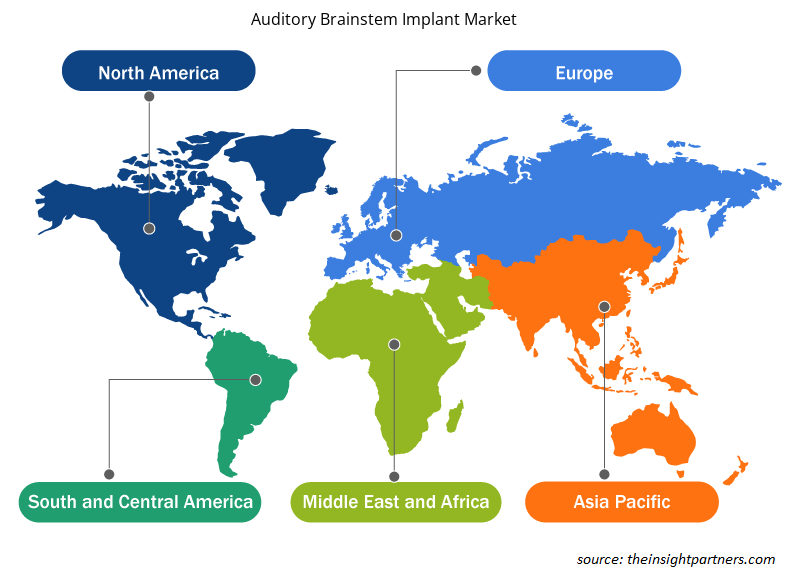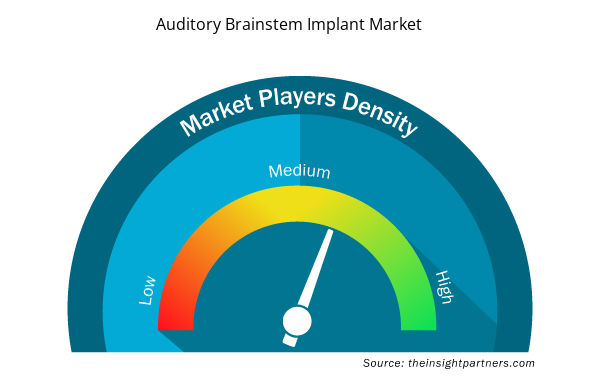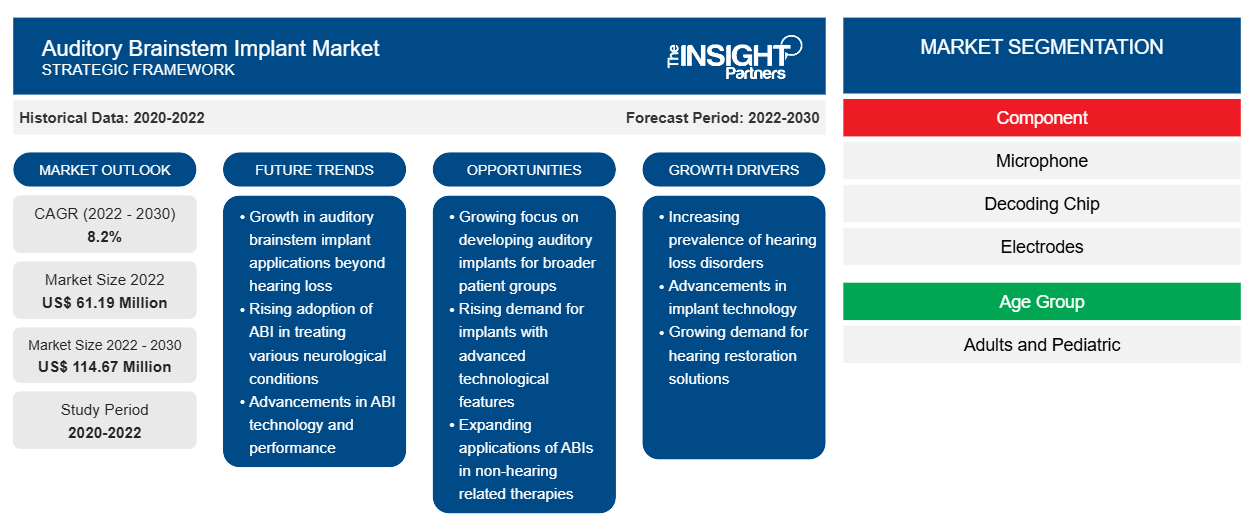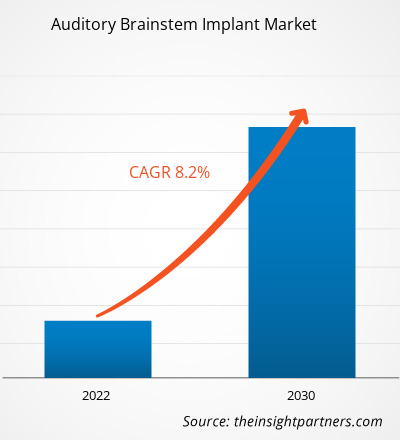[Forschungsbericht] Der Markt für auditorische Hirnstammimplantate soll von 61,19 Millionen US-Dollar im Jahr 2022 auf 114,67 Millionen US-Dollar im Jahr 2030 wachsen; von 2022 bis 2030 wird eine durchschnittliche jährliche Wachstumsrate (CAGR) von 8,2 % geschätzt.
Standpunkt des Analysten
Das auditorische Hirnstammimplantat (ABI) ist ein Gerät, das Patienten hilftan Hörbehinderungen leiden und aufgrund anatomischer Einschränkungen kein Cochlea-Implantat (CI) erhalten können. Dieses neuroprothetische Gerät umgeht den Cochlea-Nerv und stimuliert mithilfe eines mehrkanaligen Oberflächenarrays elektrisch Neuronen zweiter Ordnung im Nucleus cochlearis (CN). Es wird normalerweise für Patienten mit Cochlea- und Retrocochlea-Pathologien empfohlen.
Die Marktanalyse für auditorische Hirnstammimplantate erklärt Wachstumstreiber wiesteigende Prävalenz von sensorineuralem Hörverlust und technologische Fortschritte bei ABI-Geräten. Die hohen Kosten für chirurgische Behandlungen und begrenzte Erstattungsrichtlinien hemmen jedoch das Marktwachstum. Darüber hinaus wird erwartet, dass sich die Entwicklung von Hybridgeräten als zukünftige Trends auf dem Markt für auditorische Hirnstammimplantate im Zeitraum 2022–2030 herauskristallisieren wird.
Markteinblicke
Zunehmende Prävalenz von sensorineuralem Hörverlust treibt Wachstum im Markt für Hirnstammimplantate voran
Laut einem 2023 von StatPearls veröffentlichten Artikel werden in den USA jährlich 5 bis 27 Fälle von plötzlichem sensorineuralem Hörverlust (SNHL) pro 100.000 Menschen gemeldet, was jährlich ca. 66.000 Neuerkrankungen entspricht. Darüber hinaus leiden weltweit ca. 16 % der Erwachsenen mit behindernder Schwerhörigkeit an lärmbedingtem Hörverlust (NIHL), einer weiteren bedeutenden Ursache für Hörverlust bei Erwachsenen, die mit Lärm am Arbeitsplatz zusammenhängt. Obwohl es in den meisten Industrieländern Gesetze zur Vorbeugung von NIHL gibt, ist dies nach wie vor eine häufige Berufskrankheit. Viele Studien haben ergeben, dass ABIs bei der Wiederherstellung des Hörvermögens von Patienten mit Neurofibromatose Typ 2 (NF2) und beidseitiger Taubheit erfolgreich sind. In einem im Februar 2021 von Wolters Kluwer veröffentlichten Artikel wurde eine Studie zur Bewertung der Hirnstammimplantation bei einem 65-jährigen Mann durchgeführt, bei dem beidseitige Cochlea-Otosklerose und starker sensorineuraler Hörverlust diagnostiziert wurden. Die Studie kam zu dem Schluss, dass eine ausgeprägte Otosklerose der Cochlea zu einem schlechten Ergebnis der Cochlea-Implantation führen kann. In solchen Fällen könnte ein Auditory Brainstem Implant (ABI) als alternative Behandlung für hochgradigen sensorineuralen Hörverlust bei gehörlosen Kindern und Erwachsenen in Betracht gezogen werden, die von Hörgeräten wenig oder gar nicht profitieren und für die Cochlea-Implantate nicht geeignet sind.
Darüber hinaus hat die Verfügbarkeit moderner Hörimplantate mit innovativen Technologien deren Wirksamkeit bei der Behandlung von Hörbehinderungen verbessert. Dies hat in Kombination mit minimalinvasiven chirurgischen Verfahren eine bedeutende Rolle beim Wachstum und der Bedeutung des Marktes für Hirnstammimplantate gespielt.
Zukünftiger Trend
Die Entwicklung von Hybridgeräten wird sich im Prognosezeitraum als zukünftiger Trend auf dem Markt für auditorische Hirnstammimplantate herauskristallisieren
Die Entwicklung von Hybridgeräten, die Cochlea- und Hirnstammimplantate kombinieren, soll Patienten mit Hörverlust, die aufgrund von Anomalien der Cochlea und des Cochleanervs nicht für eine Cochlea-Implantation in Frage kommen, bessere Hörergebnisse bieten. Laut einem im Oktober 2022 im International Journal of Audiology veröffentlichten Artikel wurde eine Studie durchgeführt, die die Impedanzentwicklung nach der Implantation von Hybrid-L-Elektroden untersuchen sollte. Im Rahmen der Studie wurde 137 erwachsenen Patienten eine Hybrid-L-Elektrode implantiert und mindestens ein Jahr lang nachbeobachtet. Die Studie deutete auf ein reduziertes Gewebewachstum mit dem Hybrid-L-Elektrodenarray trotz kleinerer Kontakte hin.
Daher wird erwartet, dass die Entwicklung von Hybridimplantaten zur Reduzierung von Operationsrisiken, Komplikationen und Genesungszeiten für Patienten das Wachstum des Marktes für auditorische Hirnstammimplantate im Zeitraum 2022–2030 ankurbeln wird.
Passen Sie diesen Bericht Ihren Anforderungen an
Sie erhalten kostenlose Anpassungen an jedem Bericht, einschließlich Teilen dieses Berichts oder einer Analyse auf Länderebene, eines Excel-Datenpakets sowie tolle Angebote und Rabatte für Start-ups und Universitäten.
- Holen Sie sich die wichtigsten Markttrends aus diesem Bericht.Dieses KOSTENLOSE Beispiel umfasst eine Datenanalyse von Markttrends bis hin zu Schätzungen und Prognosen.
Berichtssegmentierung und Umfang
Der Markt für Hirnstammimplantate ist nach Komponente, Altersgruppe, Anwendung und Endbenutzer segmentiert.Basierend auf den Komponenten ist der Markt für Hirnstammimplantate in Mikrofon, Dekodierungschip und Elektroden segmentiert.
Basierend auf der Altersgruppe ist der Markt für Hirnstammimplantate in Erwachsene und Kinder unterteilt. Basierend auf der Anwendung ist der Markt in sensorineuralen Hörverlust und Schallleitungshörverlust unterteilt. In Bezug auf den Endverbraucher ist der Markt für Hirnstammimplantate in Krankenhäuser, HNO-Kliniken und ambulante chirurgische Zentren unterteilt.
Segmentanalyse:
Komponentenbasierte Erkenntnisse
Der Markt für auditorische Hirnstammimplantate ist nach Komponenten in Mikrofon, Dekodierungschip und Elektroden segmentiert.Das Segment Elektroden hatte im Jahr 2022 den höchsten Marktanteil.
Erkenntnisse auf Altersgruppenbasis
Der Markt für Hirnstammimplantate ist nach Altersgruppen in Erwachsene und Kinder unterteilt.Das Segment Erwachsene hatte 2022 einen größeren Marktanteil und wird voraussichtlich zwischen 2022 und 2030 den größten Umsatzanteil auf dem Weltmarkt haben. Dies ist auf die zunehmende Inzidenz von angeborenem schwerem Hörverlust mit Anomalien bei der erwachsenen Bevölkerung weltweit zurückzuführen, was zu einer Zunahme der Hirnstammimplantation führt. Patienten mit schwerem sensorineuralem Hörverlust (SNHL), die für eine Hörnervoperation nicht in Frage kommen oder Narben im Innenohr aufgrund eines Traumas oder einer Infektion aufweisen, haben die Hirnstammimplantation als äußerst wirksam empfunden.
Anwendungsbasierte Erkenntnisse
Der Markt ist je nach Anwendung in sensorineuralen Hörverlust und Schallleitungshörverlust unterteilt.Das Segment sensorineuraler Hörverlust hatte im Jahr 2022 den größten Marktanteil.
Endbenutzerbasierte Erkenntnisse
Der Markt für auditorische Hirnstammimplantate ist je nach Endbenutzer in Krankenhäuser, HNO-Kliniken und ambulante chirurgische Zentren unterteilt. Das Krankenhaussegment wird zwischen 2022 und 2030 mit der höchsten durchschnittlichen jährlichen Wachstumsrate (CAGR) auf dem Markt wachsen. Hirnstammimplantate erfordern komplizierte Operationen, die eine spezialisierte medizinische Betreuung erfordern, einschließlich Diagnose, Behandlung und kontinuierlicher Überwachung. Krankenhäuser spielen eine wesentliche Rolle bei der Bereitstellung umfassender Gesundheitsdienstleistungen für Patienten.
Regionale Analyse
Der Markt für Hirnstammimplantate ist geografisch in fünf Hauptregionen unterteilt: Nordamerika, Europa, Asien-Pazifik, Naher Osten und Afrika sowie Süd- und Mittelamerika. Der Markt in Nordamerika wird im Zeitraum 2022-2030 voraussichtlich deutlich wachsen.Dies ist auf Faktoren wie die hohe Verfügbarkeit und Nutzung moderner Behandlungsoptionen und die Konzentration wichtiger Hersteller in der Region zurückzuführen. Insbesondere in den USA ist die Nutzung von Hirnstammimplantaten aufgrund verschiedener Faktoren wie der zunehmenden Zahl von Hörverlusten und dem wachsenden Bewusstsein für diese Implantate hoch.
Cochlear Limited, Med-EL, Oticon Medical, Zhejiang Nurotron Biotechnology Co. Ltd. und Sonova Holding AG gehören zu den wichtigsten Marktteilnehmern, die im Bericht analysiert werden. Diese führenden Akteure konzentrieren sich auf die Ausweitung und Diversifizierung ihrer Marktpräsenz und ihres Kundenstamms und nutzen so die Geschäftsmöglichkeiten, die sich auf dem Markt für Hirnstammimplantate bieten.
Regionale Einblicke in den Markt für auditorische Hirnstammimplantate
Die regionalen Trends und Faktoren, die den Markt für Hirnstammimplantate im Prognosezeitraum beeinflussen, wurden von den Analysten von Insight Partners ausführlich erläutert. In diesem Abschnitt werden auch die Marktsegmente und die Geografie für Hirnstammimplantate in Nordamerika, Europa, im asiatisch-pazifischen Raum, im Nahen Osten und Afrika sowie in Süd- und Mittelamerika erörtert.

- Erhalten Sie regionale Daten zum Markt für auditorische Hirnstammimplantate
Umfang des Marktberichts über auditorische Hirnstammimplantate
| Berichtsattribut | Details |
|---|---|
| Marktgröße im Jahr 2022 | 61,19 Millionen US-Dollar |
| Marktgröße bis 2030 | 114,67 Millionen US-Dollar |
| Globale CAGR (2022 - 2030) | 8,2 % |
| Historische Daten | 2020-2022 |
| Prognosezeitraum | 2022–2030 |
| Abgedeckte Segmente | Nach Komponente
|
| Abgedeckte Regionen und Länder | Nordamerika
|
| Marktführer und wichtige Unternehmensprofile |
|
Marktteilnehmerdichte: Der Einfluss auf die Geschäftsdynamik
Der Markt für Hirnstammimplantate wächst rasant. Dies wird durch die steigende Nachfrage der Endnutzer aufgrund von Faktoren wie sich entwickelnden Verbraucherpräferenzen, technologischen Fortschritten und einem größeren Bewusstsein für die Vorteile des Produkts vorangetrieben. Mit der steigenden Nachfrage erweitern Unternehmen ihr Angebot, entwickeln Innovationen, um die Bedürfnisse der Verbraucher zu erfüllen, und nutzen neue Trends, was das Marktwachstum weiter ankurbelt.
Die Marktteilnehmerdichte bezieht sich auf die Verteilung der Firmen oder Unternehmen, die in einem bestimmten Markt oder einer bestimmten Branche tätig sind. Sie gibt an, wie viele Wettbewerber (Marktteilnehmer) in einem bestimmten Marktraum im Verhältnis zu seiner Größe oder seinem gesamten Marktwert präsent sind.
Die wichtigsten auf dem Markt für auditorische Hirnstammimplantate tätigen Unternehmen sind:
- Cochlear Limited
- Med-EL, Oticon Medical
- Zhejiang Nurotron Biotechnology Co. Ltd.
- Sonova Holding AG
Haftungsausschluss : Die oben aufgeführten Unternehmen sind nicht in einer bestimmten Reihenfolge aufgeführt.

- Überblick über die wichtigsten Akteure auf dem Markt für auditorische Hirnstammimplantate
Zu den wichtigsten Entwicklungen der wichtigsten Marktteilnehmer zählen:
- Im Januar 2022 erhielt die Cochlear Americas Corporation die FDA-Zulassung für ihr Nucleus 24 Cochlea-Implantatsystem. Diese Zulassung erweitert die Nutzung dieses Geräts für Personen ab fünf Jahren, die auf einem Ohr einen schweren bis hochgradigen Hörverlust [auch bekannt als einseitige Taubheit/unilateraler Hörverlust (SSD/UHL)] und auf dem anderen Ohr ein normales Hörvermögen oder einen leichten Hörverlust haben.
- Historische Analyse (2 Jahre), Basisjahr, Prognose (7 Jahre) mit CAGR
- PEST- und SWOT-Analyse
- Marktgröße Wert/Volumen – Global, Regional, Land
- Branche und Wettbewerbsumfeld
- Excel-Datensatz



Report Coverage
Revenue forecast, Company Analysis, Industry landscape, Growth factors, and Trends

Segment Covered
This text is related
to segments covered.

Regional Scope
North America, Europe, Asia Pacific, Middle East & Africa, South & Central America

Country Scope
This text is related
to country scope.
Häufig gestellte Fragen
The auditory brainstem implant majorly consists of the players including Cochlear Limited, Med-EL, Oticon Medical, Zhejiang Nurotron Biotechnology Co. Ltd., and Sonova Holding AG.
Global Auditory Brainstem Implant is segmented by region into North America, Europe, Asia Pacific, Middle East & Africa and South & Central America. The market in North America held the largest market share of US$ 25.65 million in 2022 and is expected to grow at a significant rate during the forecast period. North America Auditory Brainstem Implant is segmented into the US, Canada, and Mexico.
The microphone segment dominated the global Auditory Brainstem Implant and held the largest market share of 61.76% in 2022.
The auditory brainstem implant (ABI) is a device that helps patients suffering from hearing disabilities and who cannot receive a cochlear implant (CI) due to anatomic constraints. This neuroprosthetic device bypasses the cochlear nerve and electrically stimulates second order neurons in the cochlear nucleus (CN) using a multichannel surface array. It is usually recommended for patients who have cochlear and retrocochlear pathologies.
Rising prevalence of sensorineural hearing loss and technological advancements in ABI devices are driving the global auditory brainstem implant market.
The CAGR value of the auditory brainstem implant during the forecasted period of 2020-2030 is 8.2%.
Trends and growth analysis reports related to Life Sciences : READ MORE..
The List of Companies - Auditory Brainstem Implant Market
- Cochlear Limited
- Med-EL, Oticon Medical
- Zhejiang Nurotron Biotechnology Co. Ltd.
- Sonova Holding AG
The Insight Partners performs research in 4 major stages: Data Collection & Secondary Research, Primary Research, Data Analysis and Data Triangulation & Final Review.
- Data Collection and Secondary Research:
As a market research and consulting firm operating from a decade, we have published and advised several client across the globe. First step for any study will start with an assessment of currently available data and insights from existing reports. Further, historical and current market information is collected from Investor Presentations, Annual Reports, SEC Filings, etc., and other information related to company’s performance and market positioning are gathered from Paid Databases (Factiva, Hoovers, and Reuters) and various other publications available in public domain.
Several associations trade associates, technical forums, institutes, societies and organization are accessed to gain technical as well as market related insights through their publications such as research papers, blogs and press releases related to the studies are referred to get cues about the market. Further, white papers, journals, magazines, and other news articles published in last 3 years are scrutinized and analyzed to understand the current market trends.
- Primary Research:
The primarily interview analysis comprise of data obtained from industry participants interview and answers to survey questions gathered by in-house primary team.
For primary research, interviews are conducted with industry experts/CEOs/Marketing Managers/VPs/Subject Matter Experts from both demand and supply side to get a 360-degree view of the market. The primary team conducts several interviews based on the complexity of the markets to understand the various market trends and dynamics which makes research more credible and precise.
A typical research interview fulfils the following functions:
- Provides first-hand information on the market size, market trends, growth trends, competitive landscape, and outlook
- Validates and strengthens in-house secondary research findings
- Develops the analysis team’s expertise and market understanding
Primary research involves email interactions and telephone interviews for each market, category, segment, and sub-segment across geographies. The participants who typically take part in such a process include, but are not limited to:
- Industry participants: VPs, business development managers, market intelligence managers and national sales managers
- Outside experts: Valuation experts, research analysts and key opinion leaders specializing in the electronics and semiconductor industry.
Below is the breakup of our primary respondents by company, designation, and region:

Once we receive the confirmation from primary research sources or primary respondents, we finalize the base year market estimation and forecast the data as per the macroeconomic and microeconomic factors assessed during data collection.
- Data Analysis:
Once data is validated through both secondary as well as primary respondents, we finalize the market estimations by hypothesis formulation and factor analysis at regional and country level.
- Macro-Economic Factor Analysis:
We analyse macroeconomic indicators such the gross domestic product (GDP), increase in the demand for goods and services across industries, technological advancement, regional economic growth, governmental policies, the influence of COVID-19, PEST analysis, and other aspects. This analysis aids in setting benchmarks for various nations/regions and approximating market splits. Additionally, the general trend of the aforementioned components aid in determining the market's development possibilities.
- Country Level Data:
Various factors that are especially aligned to the country are taken into account to determine the market size for a certain area and country, including the presence of vendors, such as headquarters and offices, the country's GDP, demand patterns, and industry growth. To comprehend the market dynamics for the nation, a number of growth variables, inhibitors, application areas, and current market trends are researched. The aforementioned elements aid in determining the country's overall market's growth potential.
- Company Profile:
The “Table of Contents” is formulated by listing and analyzing more than 25 - 30 companies operating in the market ecosystem across geographies. However, we profile only 10 companies as a standard practice in our syndicate reports. These 10 companies comprise leading, emerging, and regional players. Nonetheless, our analysis is not restricted to the 10 listed companies, we also analyze other companies present in the market to develop a holistic view and understand the prevailing trends. The “Company Profiles” section in the report covers key facts, business description, products & services, financial information, SWOT analysis, and key developments. The financial information presented is extracted from the annual reports and official documents of the publicly listed companies. Upon collecting the information for the sections of respective companies, we verify them via various primary sources and then compile the data in respective company profiles. The company level information helps us in deriving the base number as well as in forecasting the market size.
- Developing Base Number:
Aggregation of sales statistics (2020-2022) and macro-economic factor, and other secondary and primary research insights are utilized to arrive at base number and related market shares for 2022. The data gaps are identified in this step and relevant market data is analyzed, collected from paid primary interviews or databases. On finalizing the base year market size, forecasts are developed on the basis of macro-economic, industry and market growth factors and company level analysis.
- Data Triangulation and Final Review:
The market findings and base year market size calculations are validated from supply as well as demand side. Demand side validations are based on macro-economic factor analysis and benchmarks for respective regions and countries. In case of supply side validations, revenues of major companies are estimated (in case not available) based on industry benchmark, approximate number of employees, product portfolio, and primary interviews revenues are gathered. Further revenue from target product/service segment is assessed to avoid overshooting of market statistics. In case of heavy deviations between supply and demand side values, all thes steps are repeated to achieve synchronization.
We follow an iterative model, wherein we share our research findings with Subject Matter Experts (SME’s) and Key Opinion Leaders (KOLs) until consensus view of the market is not formulated – this model negates any drastic deviation in the opinions of experts. Only validated and universally acceptable research findings are quoted in our reports.
We have important check points that we use to validate our research findings – which we call – data triangulation, where we validate the information, we generate from secondary sources with primary interviews and then we re-validate with our internal data bases and Subject matter experts. This comprehensive model enables us to deliver high quality, reliable data in shortest possible time.


 Holen Sie sich ein kostenloses Muster für diesen Bericht
Holen Sie sich ein kostenloses Muster für diesen Bericht